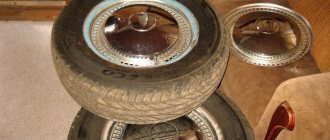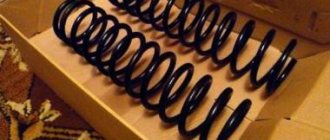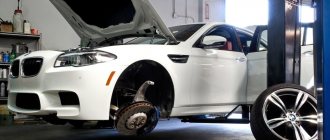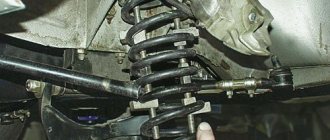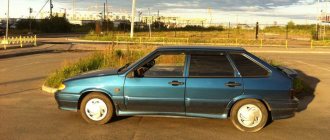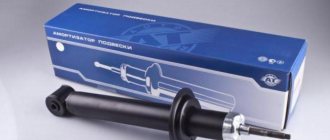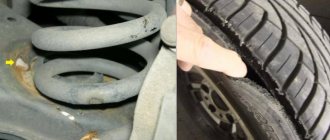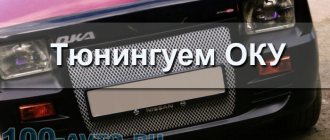At the stage of manufacturing car suspension springs, the last operation is to control the static load. Springs that do not fall within the tolerance are rejected, and the rest, depending on the obtained control load value, are divided into 2 classes. Springs with a positive load tolerance range belong to class A, and those with a minus tolerance – to class B. In this case suspension springs are marked with paint (a strip is applied with a spray on the outside of the turns) corresponding to the class.
They are marked according to hardness as follows: A – standard (hard); B – soft.
Color coding of springs by stiffness for VAZ
What to put?
Most of the springs installed on cars are marked with green (hard) or yellow paint (soft). The question arises: which ones to install, hard or not? Of course, class A or B springs have an equal right to exist. The division into classes was adopted to reduce the difference in the length of the springs on the right and left sides of the car - this is inevitable in mass production - which negatively affects handling and stability.
It is recommended to install only springs of the same class on the car. Of course, in some cases, it is allowed to install class A springs in the front suspension, and class B springs in the rear suspension. But, on the contrary, it is not possible. If you often drive with a full load, you should choose class A springs, because... They can withstand a little more load. You should know that the difference is insignificant and can range from 0 to 25 kilograms.
One of the frequently asked questions to online store managers is: “which springs are best to install”, “what does the yellow mark mean?” I will try to bring a little clarity to these questions and perhaps there will be some room for thought.
First, let's figure out what a suspension spring is, and at first glance, what such a simple element as a spring can influence. Many people do not pay any attention to the wear of this element, but this is not surprising because it does not require any adjustment or repair. kits and specials care But few people understand that springs are not all the same and their difference is not only in stiffness. There are 5 types of suspension springs, but we will not go that far into the structure of springs and their capabilities; we will consider the most common spring options, standard ones, those that are installed on VAZ, ZAZ, GAZ, AZLK cars.
Some VAZ models are equipped with so-called “barrel” springs to increase rolling resistance. Springs with variable coil pitch were also installed, but much less frequently, which ensured optimal stability with low loads, such as lateral roll, sudden braking, and acceleration. And the rigidity increased proportionally, which eliminated suspension breakdowns and maintained driving comfort over uneven surfaces.
Standard springs that were installed on VAZ, ZAZ, GAZ, AZLK cars are the best option for installation, we will consider them in detail. The production of springs is a rather complex process, step by step it can be divided into: heating and winding a rod made of rolled spring steel, from which the decarbonized layer has been removed by grinding or turning, then they are quenched in oil, the next stage is cold upsetting, then a protective layer is applied (in this case rear and front springs can be coated with different protective mixtures) and the final stage is quality control inspection, after which a stiffness class is assigned (a positive load tolerance zone refers to class “A” (usually a yellow mark), with a negative one – to “B” (green mark)). At the same time, apply the color designation of the corresponding class to the spring. Standard color marking for VAZ, ZAZ, GAZ, AZLK for front springs on the black spring is a green or yellow mark, which correspond to the stiffness class. On the rear springs, slightly different markings are used: on a white spring the same green and yellow marks are placed, but for springs with an increased length such as 2102, 2104, blue and brown (red) markings are used.
Main varieties
Before we begin to consider the types of springs for cars, let’s briefly remember why they are needed.
When moving over uneven surfaces, the car should remain soft. Otherwise, the trip will be no different from traveling by cart. To ensure comfort, automakers equip vehicles with suspension. In fact, comfort when using the suspension is an added bonus. The primary purpose of springs in a car is transport safety. When a wheel hits an obstacle at speed, such as a bump, the shock absorber softens the impact. However, to prevent the car from losing traction with the road surface, the wheel must be quickly returned to a hard surface.
Stiffness in physics notation
In the Homework section to the question what letter denotes a spring in physics, asked by the author, the European best answer is No designation spring, stiffness -K
Hello! Here is a selection of topics with answers to your question: what letter denotes a spring in physics
Reply from Dupe I know that spring stiffness is denoted by “k”, and spring...
Answer from YOUGOOOOY hardness coefficient - k
Reply from Igor Kazanzhi to
Elasticity coefficient on Wikipedia Look at the Wikipedia article about Elasticity coefficient
List of notation in physics on Wikipedia Check out the Wikipedia article about List of notation in physics
List of characters from the television series "Arrow" on Wikipedia Check out the Wikipedia article about List of characters from the television series "Arrow"
The suspension springs of any vehicle perform many important functions. Properly selected, they have a qualitative impact on the entire process of driving a car and its load-carrying capacity, make uneven road surfaces less noticeable to the driver, and increase comfort during trips, especially long ones.
Types of springs
The most common are 4 categories of car springs. They are most often installed on vehicles. At the same time, the products are somewhat different from each other, having certain characteristics and advantages.
There are 4 categories of auto springs:
- Standard. This is a basic or standard version, which is mainly installed on passenger cars from the factory. Most modern models adapted to normal operating conditions are suitable;
- Reinforced. Helps improve vehicle performance. An up-to-date solution for those for whom it is important to obtain additional strength and stability on the rear and front suspension elements for off-road driving, transporting a heavy trailer or cargo in the car itself;
- Raising. Or overpriced. Their installation makes it possible to increase the ground clearance, that is, ground clearance, and also improve the load capacity;
- Lowering. They are also called underestimators. An option for fans of sports driving. They serve to specifically reduce ground clearance and shift the center of gravity of the car.
All categories of springs are in demand and widespread in sale and use. Which ones are right for you, proceed from the operating conditions and the tasks you set for your machine.
Replacing springs may be necessary on almost any car. It's more a matter of wear and tear. If you are not going to change the operating conditions, standard products are replaced with exactly the same ones.
The procedure for replacing springs is carried out on different cars, including:
- Volkswagen Golf;
- Chevrolet Lanos;
- Renault Traffic;
- Peugeot 308;
- BMW X5;
- Skoda Octavia;
- VAZ 2110;
- VAG cars;
- Audi A8;
- Audi 100;
- Toyota Avensis;
- Mercedes ML;
- Lada Priora, etc.
The make and model do not make a fundamental difference here, since the springs can fail on any car.
But when purchasing new products, the specific brand, model, generation and a number of additional parameters must be taken into account. This allows you to select the parts that match your vehicle as accurately as possible.
Self-production of a coupling device for a walk-behind tractor
In addition to color, an important indicator of an autospring is the diameter of the structure. It is determined not by the manufacturer himself, but by the car company that designs the car model. The executor of orders for the release of springs cannot independently make any changes. All parameters are calculated and verified in advance. This will allow the car to further meet the automaker’s promises in terms of comfort, safety, ground clearance and other indicators to which springs are directly related.
The abundance of flowers should not confuse motorists. This is especially true for owners of VAZ products. In this case, class A includes white, yellow, orange and brown marks. If the mark is black, blue or cyan, then it is class B.
I briefly explained the essence of the marks. The values of the marks in kilograms and millimeters during compression and stretching, as well as their combinations for different cars may differ from each other. Here you need to specifically look at the specifications for your car. Unfortunately, you can’t tell about all the cars in one article. But in general it should be clear.
Coil springs are:
- Cylindrical.
- Conical.
Springs wound on the form can have not only a regular cylindrical shape, but also a conical one. In it, each new round is already smaller than the previous one. Such a product is used if it additionally has a supporting function. It not only responds to deformation, but also acts as a support. Conical springs can be found on classic road bikes where they support the seat.
Coil and conical springs can be conventional or compound. Compounds are double. These are 2 springs of different diameters connected together. One is located outside, and the second is placed between its turns. Thus, they work together to provide the required level of rigidity.
Independent spring block - what is it?
The independent spring block is a unique design assembled using pocket technology. Each cylindrical, double-cone or barrel-shaped spring is placed in a special pocket, which completely eliminates contact between metal parts. The wire spirals do not touch each other and the compression of one does not affect the others located nearby. The result of using pocket-type technology is the absence of metallic squeaks when moving during sleep and a point distribution of the load on the surface of the mattress. It does not bend like a hammock, which does not disturb the person lying next to it.
Choice depending on manufacturer
When choosing new springs to replace worn-out springs, many motorists often opt for original spare parts. However, similar products can be found in the assortment of other manufacturers, which have good reviews from those who have already used a similar product.
Here is a small list of the most famous manufacturers of quality springs:
- Sirius is a domestic company whose product range includes a large selection of products for different car models. All products sold correspond to the drawings provided by the customer.
- Phobos is another well-known manufacturer that offers a large selection of not only standard springs, but also backlash complexes that allow you to change the vehicle’s ground clearance depending on need. True, reviews from many users are not in favor of the manufacturer. The reason for this is the short service life of the products, regardless of the stiffness of the springs.
- "Tehnoressor" - the company offers budget products. Over time, these springs lose their stiffness, but do not sag. The brand mainly produces standard elements for pendants.
- The list of European manufacturers is opened by Koni. The Dutch manufacturer produces high-quality elements for suspensions of any vehicle, regardless of whether it is a Japanese or domestic car. The peculiarity of this product is that many parts have manual adjustment of rigidity. The driver himself can set the desired ground clearance by moving the thumbwheel to the appropriate position on the rack.
- Another European manufacturer is the German company Eibach, whose product range includes a wide variety of various parts for suspensions and chassis of cars. It is worth considering that the products of this company are very expensive, but the quality of the products compensates for the waste. Springs rarely burst, do not lose their rigidity for a long time, and do not sag.
- The SS20 company was founded in 1993, and today it provides a large selection of suspension spare parts for any domestic vehicle, as well as for many foreign cars. According to the manufacturer, the stiffness of each spring is checked on a special stand, based on which a pair is selected for the product. Thanks to this, the purchased set will consist of identical springs. In addition to a model of a specific class, the car owner can choose a product that differs in manufacturing technology.
- Kilen is an excellent replacement for standard VAZ springs. According to the manufacturer, the original spare part costs half as much as the products they offer.
- The springs have excellent resistance to heavy loads. For this purpose, special metal alloys are used, which after certain processing do not burst, and also do not sag over the years. To extend the service life of products, the manufacturer coats the springs with a special material that includes epoxy resin.
In addition to the above, we offer a short video on how to determine that the springs need to be replaced:
All about springs for Lada 4×4 5D. Buying springs Lesjöfors / Kilen
Maybe this information will be useful to someone, I searched through catalogues, was interested in DRIVE2.ru.
So, 3 types of springs were installed on the Lada 4×4 5D, depending on the year of manufacture: 1. Springs from Nadezhda: Front 2120-2902712 (rod diameter 16mm, free length 273mm, stiffness 89.56 kgf/cm) Rear 2120-2912712 (diameter rod 14.2 mm, free length 405 mm, hardness 30.96 kgf/cm)
2. Springs from Niva 2121: Front 2121-2902712 (bar diameter 15.2 mm, free length 278 mm, stiffness 74.42 kgf/cm) Rear 2121-2912712 (bar diameter 13 mm, free length 434 mm, stiffness 22.44 kgf/cm)
3. For cars produced since 2010, the so-called emki: Front: 21214-2902712-00 (bar diameter 15.2 mm, free length 289 mm) Rear: 21210-2912712-00 (bar diameter 13 mm, free length 434 mm, hardness 22, 44kgf/cm)
Popular foreign analogue: Front: Lesjöfors 4047006/Kilen 15033 (for long wheelbase) (bar diameter 15mm, free length 288mm, stiffness 75.8 kgf/cm) Rear: Lesjöfors 4247002/Kilen 15033 (bar diameter 13mm, free length 4 41mm, hardness 22 ,3kgf/cm)
There are also rear reinforced ones: Lesjöfors 4247010/Kilen 55037, (rod diameter 13.75 mm, length 415 mm, stiffness 29.7 kgf/cm).
Also on the Lada 4×4 5D springs from the VAZ 2123 are installed: Front: 2123-2902712 (bar diameter 15.7 mm, free length 313 mm, stiffness 75 kgf/cm) Rear: 2123-2912712 (bar diameter 13.9 mm, free length 410 mm, hardness 30kgf/cm)
Having measured the thickness of the rod on the rear springs, I determined that I have springs from a short Niva (2121-2912712), the diameter of the rod is 13 mm (accordingly, the length will be 434 mm), for comparison, on springs from Nadezhda (2120-2912712) the diameter of the rod is 14.3 mm ( length 405mm). I didn’t want to take domestic ones, since according to reviews they sag quickly, so I opted for rear springs Lesjöfors 42 470 02 (bar diameter 13mm, length 441mm).
Source
Springs are classified into the following types according to their impact:
- Bend.
- Torsion.
- Stretching.
- Squeezing.
Flexion springs resist the force directed at their bending. This quality is used to press machine parts together. An example is disc springs.
Torsions are equipped with elongated, smooth edges of hooks, which are fixed in the mechanisms. If you try to change their normal position in any direction, they return back due to the elasticity of the coiling of the main body. An example of such elements are torsion springs in clothespins.
Compression and tension have a similar structure and differ only in the size of the gap between the turns of the winding. The compression element reacts when subjected to pressure. This is the type of spring used in pressure keys.
Why is color coding required?
The mark placed on the product will help the motorist select a modification that meets his needs. If you install springs of different stiffnesses on a car, the body will not be parallel to the road. In addition to the unaesthetic appearance, this is fraught with instability during driving - one part of the car will be depreciated in a mode different from the other side of the vehicle.
The same applies to the height of the products. In this case, of course, the size of the parts is often compared. To speed up the process of sorting products, manufacturers apply a color mark to all products that corresponds to specific technical characteristics.
Springs Kilen-Lesjofors, coating
I cannot help but note the issue of spring coating. The most important difference from other manufacturers is not the paint. Primary coating is made with zinc phosphate, secondary with epoxy powder. Let me note an important thing. Spring coating isn't just about "beauty" - it's about long-lasting performance. Metal whose structure has been penetrated by rust is, in most cases, scrap metal. In St. Petersburg conditions, the coating lasted more than 7 years before the first chips appeared on the springs.
Source
What is the spring made of?
For the production of springs, specialized wire with increased elasticity parameters is used. All types of springs are made from it, except disc springs. The latter are manufactured by stamping on sheet steel.
Spring wire is produced by rolling from a specific steel alloy. Thanks to the specialized composition, after heat treatment, the finished product does not break under mechanical stress within the limits of design loads. It also acquires increased resistance to loss of elasticity after repeated deformation.
Usage and differences
The springs come in a variety of colors to help the driver select the correct replacement spring. It is allowed to install springs of both classes A and B on the car, but the colors must be identical. If this rule is violated, the body will tilt to one side.
You cannot install springs of different classes on a car. In this case, class A springs can be installed on the front axle, and class B springs on the rear axle. Any other order is unacceptable. Color and grade must be the same.
It is believed that class A springs are stiffer than class B springs, regardless of color. This is only partly true. Class "A" is ideal for vehicles with a larger load. It should be noted that there are spring samples without mandatory markings. Such elements are not worth purchasing, much less using.
Only springs of proper quality should be installed; they will ensure a soft ride, little wear and tear on the vehicle and an average load on the driver.
Interesting
Very often, class A and B markings are also called hardness markings. Indeed, if you need to regularly travel with a full load, then it is better to use class A, as they can withstand a slightly larger load. However, this difference is small and amounts to approximately 25 kg.
Manufacturers do not always apply markings in accordance with the requirements of current standards. However, the color marking of the spring, assigning it to a certain class, must be applied. Moreover, it must be the same on both springs purchased, matching each other in color. If there is no such color marking, then it is better to refrain from purchasing them. » alt=»»>
Source
How to make a spring at home
In almost every mechanism where a spring is used, it has its own parameters of diameter and height. As a result, after it wears out, it becomes difficult to replace. For fairly modern mechanisms, springs can be ordered from a spare parts supplier, but for old ones that have already been discontinued, this is not possible.
In this case, you can make the spring yourself. To produce it at home, you need spring wire. Since it is often sold in weights of 1 kg or more, this is too much to produce one spring. In this case, you can purchase any spring made from wire of the required diameter at a hardware or auto store.
Using it as a source of material, you can manufacture a product with the required parameters by repeating the factory technology in a simplified version. When heat treating springs in production, their heating and cooling is done with precise temperature control by measuring equipment.
Carbon steel spring wire according to GOST 9389-75
The standard applies to cold-drawn carbon steel wire used for the manufacture of cold-wound springs that are not quenched. The wire is manufactured: according to mechanical properties: grades A, B, C; classes 1, 2, 2A, 3; by manufacturing accuracy: normal accuracy; increased accuracy P. Wire of classes 1, 2, 3 is manufactured with normal and increased accuracy, class 2A - increased accuracy
Recommendations for the use of spring wire according to GOST 9389
| Wire grade | Wire strength class | Conditions of use |
| A | 1 | For springs K no more than 0.10 |
| B | 1; 2; 2A; 3 | For springs K no more than 0.17 |
| IN | 1; 2; 2A; 3 | For springs K no more than 0.30 |
Note The relative strength run-up index K is calculated using the formula K = ΔσВ / σВ, where ΔσВ is the run-up of temporary tensile strength, N/mm2; σB - minimum value of tensile strength in class, N/mm2
Examples of designations: Wire grade A, class 1, increased accuracy, diameter 1.20 mm: Wire A-1-P-1.20 GOST 9389-75 The same, grade B, class 3, normal accuracy, diameter 2.00 mm :Wire B-3-2.00 GOST 9389-75
Mechanical properties of spring wire according to GOST 9389-90
| Wire diameter, mm | Time resistance rupture, N/mm2 class 1 | Time resistance rupture, N/mm2 class 2; 2A | Time resistance rupture, N/mm2 class 3 | ΔσВ, N/mm2 Brand A class 1 | ΔσВ, N/mm2 Brand B class 1; 2; 2A; 3 | ΔσВ, N/mm2 Brand B class 1 | ΔσВ, N/mm2 Brand B class 2; 2A | ΔσВ, N/mm2 Brand B class 3 |
| 0,20 | 2700-3040 | 2260-2700 | 1770-2260 | 300 | 300 | 340 | 440 | 490 |
| 0,22 | 2700-3040 | 2260-2700 | 1770-2260 | 300 | 300 | 340 | 440 | 490 |
| 0,25 | 2700-3040 | 2260-2700 | 1770-2260 | 300 | 300 | 340 | 440 | 490 |
| 0,28 | 2700-3040 | 2260-2700 | 1770-2260 | 290 | 290 | 340 | 440 | 490 |
| 0,30 | 2700-3040 | 2260-2700 | 1770-2260 | 280 | 280 | 340 | 440 | 490 |
| 0,32 | 2650-2990 | 2210-2650 | 1720-2210 | 270 | 280 | 340 | 440 | 490 |
| 0,36 | 2650-2990 | 2210-2650 | 1720-2210 | 260 | 280 | 340 | 440 | 490 |
| 0,40 | 2600-2940 | 2160-2600 | 1670-2160 | 250 | 280 | 340 | 440 | 490 |
| 0,45 | 2600-2940 | 2160-2600 | 1670-2160 | 240 | 260 | 340 | 440 | 490 |
| 0,50 | 2600-2940 | 2160-2600 | 1670-2160 | 230 | 260 | 340 | 440 | 490 |
| 0,56 | 2600-2940 | 2160-2600 | 1670-2160 | 210 | 260 | 340 | 440 | 490 |
| 0,60 | 2600-2940 | 2160-2600 | 1670-2160 | 200 | 240 | 340 | 440 | 490 |
| 0,63 | 2550-2890 | 2160-2550 | 1670-2160 | 190 | 240 | 340 | 390 | 490 |
| 0,70 | 2550-2890 | 2160-2550 | 1670-2160 | 180 | 240 | 340 | 390 | 490 |
| 0,80 | 2550-2890 | 2110-2550 | 1670-2110 | 170 | 230 | 340 | 440 | 440 |
| 0,90 | 2500-2790 | 2110-2500 | 1620-2110 | 160 | 230 | 290 | 390 | 490 |
| 1,00 | 2450-2740 | 2060-2450 | 1570-2060 | 150 | 220 | 290 | 390 | 490 |
| 1,10 | 2400-2700 | 2010-2400 | 1520-2010 | 150 | 220 | 290 | 390 | 490 |
| 1,20 | 2350-2650 | 1960-2350 | 1520-1960 | 150 | 210 | 290 | 390 | 440 |
| 1,30 | 2300-2600 | 1960-2300 | 1520-1960 | 150 | 210 | 290 | 340 | 440 |
| 1,40 | 2260-2550 | 1960-2260 | 1470-1960 | 150 | 200 | 290 | 340 | 440 |
| 1,50 | 2210-2500 | 1860-2210 | 1420-1860 | 150 | 200 | 290 | 340 | 440 |
| 1,60 | 2160-2450 | 1860-2160 | 1420-1860 | 150 | 200 | 290 | 290 | 440 |
| 1,70 | 2060-2350 | 1770-2060 | 1370-1770 | 150 | 200 | 290 | 290 | 390 |
| 1,80 | 2060-2350 | 1770-2060 | 1370-1770 | 150 | 200 | 290 | 290 | 390 |
| 1,90 | 2010-2300 | 1770-2010 | 1370-1770 | 150 | 200 | 250 | 250 | 390 |
| 2,00 | 2010-2260 | 1770-2010 | 1370-1770 | 150 | 200 | 250 | 250 | 340 |
| 2,10 | 1960-2210 | 1720-1960 | 1370-1720 | 150 | 200 | 250 | 250 | 340 |
| 2,20 | 1910-2160 | 1670-1910 | 1320-1670 | 150 | 200 | 250 | 250 | 340 |
| 2,30 | 1910-2160 | 1670-1910 | 1320-1670 | 150 | 200 | 250 | 250 | 340 |
| 2,50 | 1810-2060 | 1620-1660 | 1270-1620 | 150 | 200 | 250 | 250 | 340 |
| 2,80 | 1770-2010 | 1620-1860 | 1270-1620 | 150 | 200 | 250 | 250 | 340 |
| 3,00 | 1720-1960 | 1620-1860 | 1270-1620 | 150 | 200 | 250 | 250 | 290 |
| 3,20 | 1720-1960 | 1520-1770 | 1230-1520 | 150 | 200 | 250 | 250 | 290 |
| 3,50 | 1670-1910 | 1520-1770 | 1230-1520 | 150 | 200 | 250 | 250 | 290 |
| 3,60 | 1670-1910 | 1520-1770 | 1230-1520 | 150 | 200 | 250 | 250 | 290 |
| 4,00 | 1620-1860 | 1470-1720 | 1180-1470 | 150 | 200 | 250 | 250 | 290 |
| 4,20 | 1570-1810 | 1420-1670 | 1130-1420 | 150 | 200 | 250 | 250 | 250 |
| 4,50 | 1520-1770 | 1370-1620 | 1130-1370 | 150 | 200 | 250 | 250 | 250 |
| 5,00 | 1470-1720 | 1370-1620 | 1130-1370 | 150 | 200 | 250 | 250 | 250 |
| 5,60 | 1420-1670 | 1320-1570 | 1080-1320 | 150 | 200 | 250 | 250 | 250 |
| 6,00 | 1420-1670 | 1320-1570 | 1080-1320 | 150 | 200 | 250 | 250 | 250 |
Wire diameters (according to GOST 9389) and theoretical weight 1000 m
| Diameter, mm | Weight, kg | Diameter, mm | Weight, kg | Diameter, mm | Weight, kg | Diameter, mm | Weight, kg |
| 0,14 | 0,1208 | 0,15 | 0,1387 | 0,16 | 0,1578 | 0,18 | 0,1994 |
| 0,20 | 0,2465 | 0,22 | 0,298 | 0,25 | 0,385 | 0,28 | 0,484 |
| 0,30 | 0,555 | 0,32 | 0,631 | 0,36 | 0,80 | 0,40 | 0,99 |
| 0,45 | 1,25 | 0,50 | 1,54 | 0,56 | 1,93 | 0,60 | 2,22 |
| 0,63 | 2,45 | 0,70 | 3,02 | 0,75 | 3,47 | 0,80 | 3,95 |
| 0,85 | 4,45 | 0,90 | 4,99 | 1,00 | 6,17 | 1,10 | 7,46 |
| 1,20 | 8,88 | 1,30 | 10,42 | 1,40 | 12,08 | 1,50 | 13,87 |
| 1,60 | 15,78 | 1,70 | 17,82 | 1,80 | 19,94 | 1,90 | 22,26 |
| 2,00 | 24,65 | 2,10 | 27,19 | 2,20 | 29,83 | 2,30 | 32,58 |
| 2,50 | 38,54 | 2,80 | 48,36 | 3,00 | 55,50 | 3,20 | 63,11 |
| 3,40 | 71,28 | 3,50 | 75,52 | 3,60 | 79,9 | 4,00 | 98,7 |
| 4,20 | 108,7 | 4,50 | 124,8 | 5,00 | 154,2 | 5,60 | 193,3 |
| 6,00 | 221,9 | 6,30 | 244,4 | 6,50 | 260,5 | 6,70 | 276,8 |
| 7,00 | 302,1 | 7,50 | 346,8 | 8,00 | 394,6 |
Classification of suspension springs by color
To choose the right spring for your car, the motorist must pay attention not only to the markings in the form of colored stripes applied to the outer side of the coils. An important factor is also the color of the spring itself.
Some people think that the coloring of these parts serves only a protective function (the paint is actually applied to prevent the formation of metal corrosion). In fact, first of all, this is done so that neither the motorist nor the auto parts seller makes a mistake in choosing a part.
Thus, the color of the spring body indicates the model of the car, as well as the installation location - rear or front element. Typically, the front spring for VAZ family cars is painted black, and the coils are marked accordingly, which will indicate the degree of stiffness.
There are also blue modifications with variable interturn spacing. For classics, such parts can be placed on the front part of the suspension.
Here is a small table of what color a specific spring will be designated for some VAZ models. Class A indicated in the table is a hard characteristic, and class B is a soft one. The first part is marking the stiffness of the front elements:
| Automobile model: | Spring body color | “A” class marking: | Marking "B" class: |
| 2101 | black | green | yellow |
| 2101 variable pitch | Metallic blue | green | yellow |
| 2108 | black | green | yellow |
| 2110 | black | green | yellow |
| 2108 variable pitch | Metallic blue | green | yellow |
| 2121 | black | not marked | white |
| 1111 | black | green | white |
| 2112 | black | not marked | white |
| 2123 | black | not marked | white |
The second part presents the rear spring stiffness markings:
| Automobile model: | Spring coils: | "A" class markers: | Markers "B" class: |
| 2101 | white | green | yellow |
| 2101 variable pitch | Metallic blue | green | yellow |
| 2102 | white | blue | red |
| 2102 variable pitch | Metallic blue | green | yellow |
| 2108 | white | green | yellow |
| 2108 variable pitch | Metallic blue | green | yellow |
| 21099 | white | blue | red |
| 2121 | white | black | not marked |
| 2121 variable pitch | Metallic blue | green | yellow |
| 2110 | white | black | not marked |
| 2110 variable pitch | Metallic blue | green | yellow |
| 2123 | white | black | not marked |
| 2111 | white | blue | orange |
| 1111 | white | green | not marked |
Manufacturing Features
Most machine parts are manufactured using a specific technology, so they comply with standards. However, in the case of spring production there is a slight subtlety. The manufacturing process of a part can involve operations that are often difficult to control.
For this reason, companies involved in the mass production of car springs cannot create identical parts. After leaving the assembly line, each spare part from this category is tested for rigidity. After comparing with the standard, specialists apply special marks to the products. Marking allows you to classify each product into groups, which are mentioned a little higher.
Differences between springs depending on their markings
If the paint designation indicates the rigidity of the part, and this parameter may vary depending on what raw materials the manufacturer uses, then the diameter of the threads must exactly correspond to the requirements of the automaker. Everything else remains at the discretion of the company fulfilling the order for the production of these products.
At the factory they can:
- Use blanks of different diameters. Automakers also allow the creation of springs with varying diameters within acceptable limits. For example, the initial turns may be thinner than the main turns.
- Change the height of the springs, as well as create parts that are identical in size, but have a different stiffness parameter.
- Change the number of turns and the distance between them, while taking into account the outer diameter required by the automaker. Regardless of the interturn distance, the element can be either soft or hard.
A simple procedure helps determine the conformity of the finished product to the manufacturer. The spring is compressed with a specific force and the height is measured in this state. If the product does not fit within the framework established by the car manufacturer, the part is considered defective.
Based on such control, suitable products are also divided into two classes - A and B. The first class is products whose length, when compressed with a certain force, is maximum (within the limits of the manufacturer's data for specific cars). The second class corresponds to the lower limit of the same parameter.
All products that fall into a specific class receive their own designation. Paint is used for this. For models of the VAZ family, the class A color marker will be represented in yellow, orange, white and brown.
However, the same classic can also be equipped with springs included in the second category. In this case, they will be distinguished by green, black, blue and blue.
What does the marking say?
If you take a car spring, you will notice that different products may have different colors with which they are marked.
All marks are often colored. The following shades are used:
- yellow;
- orange;
- blue paint;
- brown;
- orange;
- green;
- pink;
- black;
- white.
Moreover, the last two colors are found mainly not as a method of marking, but simply as the color basis of the product itself.
Differences in color make it possible to determine the degree of hardness relevant for a particular sample as simply and clearly as possible. Special tests are carried out at factories. The springs are compressed with a regulated force and the height is measured. If a part does not meet the specified parameters, it is rejected.
All designs that have successfully passed tests receive class A or B. Class A is relevant for springs that fall within the upper tolerance range, that is, hard ones, and class B for softer ones. The height of the latter corresponds to the lower tolerance zone.
Based on their design, springs are classified into several types:
- Screw.
- Torsion bars.
- Spiral.
- Disc-shaped.
- Wave.
Screw ones are the most widespread. They are tube shaped. The element is obtained by winding a wire or rod onto a cylindrical template. After which the workpiece can be hardened and tempered. Depending on the winding method, the direction of operation of the spring depends.
The presence of gaps between the turns allows it to be used as a compression element. An example is springs in ballpoint pens, car suspensions, and motor vehicles. When tightly wound, the spring is triggered by tension. Such elements have hooks on the edges of the eyelets. They are used in automatic door closing mechanisms.
Torsion bars have a similar design to screw bars. However, they are designed to respond to torsion and bending. The ends of such springs are made elongated for hooking during installation. When exposed to torsion, the element resists. Torsion springs, for example, are used in complex door closing mechanisms.
Spiral ones have the shape of a ribbon twisted into a spiral. This element is used to store energy. When installed in the mechanism, it twists, accumulating energy for unwinding due to its elasticity. These are the springs that are used in watch movements that operate in factories without the use of an electrical power source. They are also used in manual starters for chainsaws, lawn mowers for returning the cord back, etc.
A disc spring looks like a washer curved into a cone. Due to the elasticity of the metal, it resists compression. They constantly support nuts or other components. This is a rather rarely used element, but it is widely used in the steering rack mechanisms of most cars.
Wave ones are a tape laid in a sinusoid, that is, a wave. It is wound in a circle, like screw products. However, thanks to the wave-like laying during compression, it acts back equally across the entire plane without tending to move to the side.
Special alloy steel spring wire
according to GOST 14963-78
Designed for the manufacture of springs subjected to heat treatment (hardening and tempering) after winding.
Wire is divided: according to the manufacturing method and the quality of surface finishing into groups: with special surface finishing by removing the surface layer - A, B, C, D, E; without special surface finishing H; by manufacturing accuracy: normal accuracy; increased accuracy P; by purpose: for cold coil springs XN; for hot coil springs GN; according to mechanical properties, surface quality into classes: 1 - for springs for critical purposes; 2 - for general purpose springs
Nominal wire diameters, mm: 0.5; 0.56; 0.60; 0.63; 0.71; 0.80; 0.90; 1.10; 1.20; 1.25; 1.30; 1.40; 1.50; 1.60; 1.80; 2.0; 2.20; 2.50; 2.80; 3.00; 3.20; 3.50; 3.80; 4.00; 4.20; 4.50; 4.80; 5.00; 5.50; 5.60; 6.00; 6.20; 6.30; 6.50; 7.00; 7.10; 7.50; 8.00; 8.50; 9.00; 9.50; 10.00; 11.00; 11.20; 11.50; 12.00; 12.50; 13.00; 14.00
Wire of groups A, B, C, D should be made with a diameter of 1 - 14 mm, wire of groups E, H - with a diameter of 0.5 - 14.0 mm
An example of the designation of wire made of steel grade 51HFA, with a special surface finish, polished, group A of increased precision, class I for cold coil springs, with a diameter of 1.80 mm: Wire 51HFA -A - P- I -HN -1.80 GOST 14963- 78
Technical requirements
The wire must be made of steel grades 51ХФ 60С2А, 65С2ВА, 70СЗА in accordance with GOST 14959-79. The temporary tensile strength of the wire for cold coil springs should be no more than 1029.5 MPa. Wire made of steel grade 51HFA on heat-treated samples must have a temporary tensile strength of at least 1470 MPa, a relative narrowing after breaking of at least 40%. Wire of groups A, B, C, D must be manufactured in rods; wire of groups E, H - in coils
Headrest with monitor: comfortable travel for rear passengers
The production of springs for cars involves various technologically complex operations. Not all of them can be controlled. Some of them are even impossible to follow directly until the result is obtained in the form of a finished spring for a vehicle suspension.
Thus, a classification by color arose. This is one of the few ways to distinguish elements of different stiffness indicators after their manufacture has been completed. Yes, there are alternative methods, but color is considered the most simple, reliable and informative.
How are springs marked, what does the color of springs on VAZ cars mean?
Suspension springs perform several important functions. In addition to having a significant impact on the handling and load-carrying capacity of the vehicle, they also smooth out uneven road surfaces and increase comfort while driving. However, it is very important that springs of the same class are used in the chassis. To avoid mistakes when installing them, manufacturers must mark the springs.
- Classification
- Manufacturing Features
- Differences between suspension springs and their markings
- Important
- Interesting
The operating spring stiffness depends on a number of parameters:
- Chemical composition of the metal.
- Heat treatment method.
- Diameter of the wire used.
- Number of turns.
- Turning frequencies.
One of the most important parameters when choosing a spring is its stiffness coefficient. It determines how much force is required to compress or stretch the finished product. This parameter is a consequence of complex engineering calculations that take into account many indicators of the mechanism in which the spring must be installed.
If the spring matches the mechanism in length and diameter, but it requires significantly more force than required to deform it, then the system will not be able to work. In essence, the developed clamping force is not capable of causing an elastic response. If, on the contrary, the stiffness of the spring is not enough, then, having stretched under load, it will not return back. A similar situation will occur during compression.
The stiffness of all types of springs depends on temperature. When selecting them, it is optimal to assess the hardness at the temperature at which it will be used. The warmer it is, up to a certain threshold of metal stability, the higher the elasticity. When cooled, the structure of the metal changes, and the springs acquire less travel and increased fragility.
What springs are suitable for Lada 4×4
When making this choice, you should take into account the dimensions of the Lada 4×4 springs. If they do not correspond to the standard ones (for example, the springs from the Chevrolet Niva are longer), then other suspension elements will have to be changed, for example, shock absorbers, spacers, etc. The result is an elevator. To minimize costs, car enthusiasts simply cut off excess coils from the springs.
What springs can be installed on Lada 4×4:
So, which springs are best to choose? They should not be too hard (when the wheel loses contact with the road or the car “bounces”) or too soft (when the body rolls heavily when cornering, “nods off” when braking, and the suspension often breaks). You need to be able to choose the right balance that will be suitable specifically for your car and its operating conditions. For example, when installing a heavier engine (diesel), the springs should also be stiffer.
What springs did you choose for your SUV? What features did you notice during their operation? Leave feedback and take part in the survey.
Source
Properties of suspension springs
For car springs, there is such a thing as fatigue, and they sag. This means that the distance between turns becomes smaller over time. Because of this, part of the car begins to sag. In such cases, the part must be replaced.
If the springs are not replaced, this may have the following consequences:
- When the rear part sag, the carrying capacity of the vehicle is reduced, and on large bumps the soft suspension will not protect against impact, for example, with a muffler on the ground;
- On the same bumps, the wheels will begin to rub against the wheel arch protection;
- The shock absorber will wear out faster, and if it subsides too much, the part may break through, since the piston will often collide with the base of the liner with oil;
- Failure of the shock absorber will also negatively affect the body elements - most often in this case the fastening suffers;
- Old springs may have a coil that breaks, causing the car to lose control.
Depending on the operating conditions, car springs can be maintained for five to ten years, but if you constantly drive over potholes, these parts may require replacement even earlier. There are cases when such elements have not been looked after for even three years.
In addition to natural compression loads, pebbles can fly out from under the wheel while driving on the road. When they hit the spring, they can cause paint chips. Exposed metal will be subject to an oxidation reaction, which will also reduce the life of the part.
Previously, torsion bars were used as dampers on cars. Thanks to the use of springs, vehicles have become more comfortable and their handling has improved.
To choose the right springs for your car, you need to pay attention to the following factors:
- The thicker the rod from which the spring is made, the stiffer the product will be;
- The stiffness parameter also depends on the number of turns - the more there are, the softer the suspension;
- Not every spring shape is suitable for a particular vehicle. Non-compliance with the parameters specified by the vehicle manufacturer can lead to discomfort (for example, while driving, a large spring will rub against the fender liner), and sometimes even worsen handling.
Don't buy the stiffest springs. They improve steering response, but reduce traction. On the other hand, softer analogues will create a lot of inconvenience for country roads. For these reasons, first of all, you need to start from which roads the car is driven on most often.
When to change?
Let me refer to quotes from the forums: look at how your lower control arm is relative to the ground, measure the distance from the edge of the wheel to the arch, and the like. Of course, there is some truth in all this, BUT these are all consequences. We need to look at the reason, that is, at the spring itself. The next legitimate question is: where to look? The photo shows springs from the same car, one side before replacing the springs, the other after.
when to change springs?
Correspondence of spring markings to the model
Let's look at what springs need to be used in specific models of the VAZ automaker:
- Springs 2101 are intended only for “penny”;
- A more rigid modification is marked 21012. They are made from thicker rods, which makes the products stronger than the previous analogue. They are installed on classics, which require a more energy-intensive suspension;
- Springs with symbols 2102 are intended for station wagons models 2102 and 21014. Compared to previous modifications, these parts are two centimeters longer. They can be installed on a sedan, but only if the car is used in rural areas. Such springs slightly increase the vehicle's ground clearance. However, they cannot be installed to enable the vehicle to carry heavier loads than those intended by the manufacturer. Otherwise, the body will have to be repaired very soon.
- The designation 2108 is given to parts intended for front-wheel drive VAZ cars. The exception is Oka and models with a 16-valve engine. It is worth considering that these same springs are also intended for 21099. There are no separate springs for this model, so the seller’s offer to purchase “originals” for the 99th is nothing more than an attempt to sell standard parts at a higher cost.
- Elements from European manufacturers marked 2110 are intended for models starting with 21102 and ending with 21104, as well as for VAZ-2112 and 2114. The European version makes the car 2 centimeters lower, but makes it more controllable at high speeds. You should not use such parts on vehicles that often travel on dirt roads and rough terrain.
- Modifications 2111 are intended for rear suspensions of models with identical markings, as well as VAZ-2113.
- Springs from category 2112 are intended for the front part of the suspension of the following models: 21113, 21103 and 2112.
- All-wheel drive vehicles of the VAZ family are equipped with 2121 springs.
